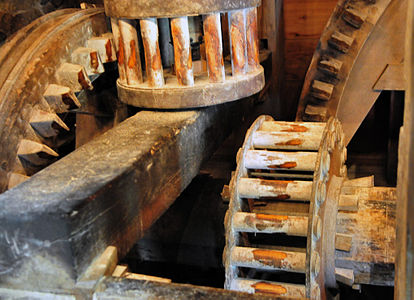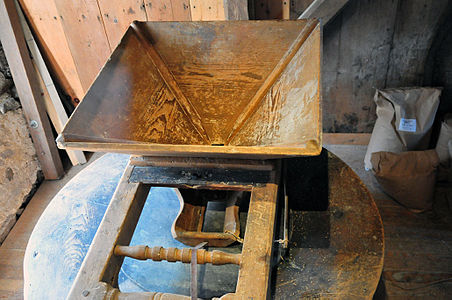
Brandywine Creek is a tributary of the Christina River in southeastern Pennsylvania and northern Delaware in the United States. The Lower Brandywine is 20.4 miles (32.8 km) long and is a designated Pennsylvania Scenic River with several tributary streams. The East Branch and West Branch of the creek originate within 2 miles (3 km) of each other on the slopes of Welsh Mountain in Honey Brook Township, Pennsylvania, about 20 miles (32 km) northwest of their confluence.
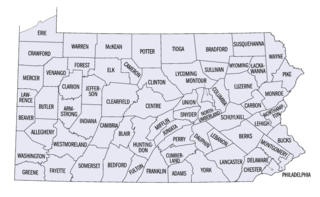
This is a list of properties and districts listed on the National Register of Historic Places in Pennsylvania. As of 2015, there are over 3,000 listed sites in Pennsylvania. All 67 counties in Pennsylvania have listings on the National Register.

Chester Springs is an unincorporated community in Chester County, Pennsylvania, United States. It is centered on West Pikeland Township, and extends into Charlestown Township, Upper Uwchlan Township, Wallace Township, East Nantmeal Township, and West Vincent Township. The Chester Springs Historic District is located in Chester Springs.
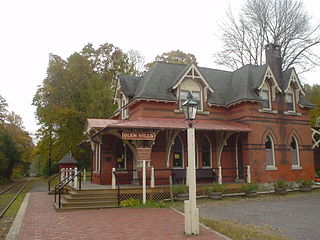
Glen Mills is an unincorporated community in Concord Township, Delaware County, Pennsylvania, United States, located approximately 27 miles west of Philadelphia. The ZIP Code for Glen Mills is 19342.

The Peotone Mill, formerly known as the Rathje Mill, is located in the village of Peotone, Illinois, which is in Will County, Illinois, United States. The mill was donated to the Village of Peotone in the early 1980s. The building is listed on the National Register of Historic Places as well as the Will County Register of Historic Places.
Ellis Paxson Oberholtzer was an American biographer and historical writer.

The Newlin Mill Complex, also referred to as The Newlin Grist Mill, is a water-powered gristmill on the west branch of Chester Creek near Concordville, Pennsylvania built in 1704 by Nathaniel and Mary Newlin and operated commercially until 1941. During its three centuries of operation, the mill has been known as the Lower Mill, the Markham Mill, the Seventeen-O-Four Mill and the Concord Flour Mill. In 1958 the mill property was bought by E. Mortimer Newlin, restored and given to the Nicholas Newlin Foundation to use as a historical park. Water power is still used to grind corn meal which is sold on site. The park includes five historical buildings, which were added to the National Register of Historic Places in 1983, and 150 acres (61 ha) of natural woodland.
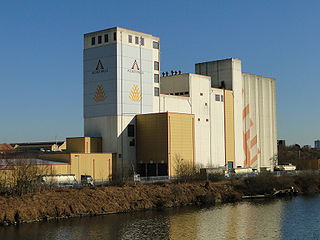
A gristmill grinds cereal grain into flour and middlings. The term can refer to either the grinding mechanism or the building that holds it. Grist is grain that has been separated from its chaff in preparation for grinding.
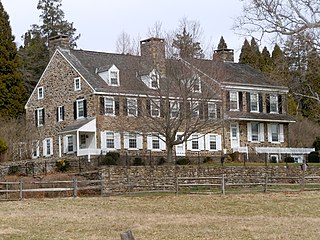
The Warwick Furnace Farms is a historic district that is located in northern Chester County, Pennsylvania, United States that includes the ruins of an early iron furnace that was owned by Anna Rutter Nutt, widow of Samuel Nutt.
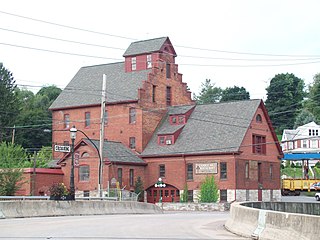
Gamble Mill, also known as Lamb Mill, Thomas Mill, Wagner Mill, and Bellefonte Flouring Mill, is an historic grist mill located at Bellefonte, Centre County, Pennsylvania.

The Gooseville Mill/Grist Mill is a historic mill on the North Branch Milwaukee River in Gooseville, Wisconsin. The mill was built in 1879 to replace an 1855 mill that had burned down. The mill is a small custom mill with board and batten siding and is typical of the custom mills common in Sheboygan County in the 1800s. A Lefel turbine powered the mill, replacing the paddle wheel used in the 1855 mill. A burr mill was used to grind the grain processed at the mill. As of 1984, the mill was still operational and occasionally used as a sawmill.

The Griesemer-Brown Mill Complex is an historic grist mill complex which is located on Monocacy Creek in Amity Township, Berks County, Pennsylvania.

The Nathan Cooper Gristmill is a historic gristmill on the Black River located at 66 NJ Route 24 in Chester Township, Morris County, New Jersey. It was added to the National Register of Historic Places on November 21, 1976 for its significance in industry.

The Great Valley Mill, also known as the Old Grist Mill in the Great Valley, is an historic grist mill which is located in Tredyffrin Township, Chester County, Pennsylvania.

The Reading Furnace Historic District is a national historic district that is located in Warwick Township and East Nantmeal Township, Chester County, Pennsylvania.

Captain Samuel Van Leer was a military officer from Pennsylvania who served as a captain in the Continental Army during the American Revolutionary War and as a lieutenant in the Chester County Light Horse Volunteers from 1781 to 1785. After his retirement from the military, he owned the Reading Furnace ironworks.

The Colonial Industrial Quarter in Bethlehem, Pennsylvania is considered America's earliest industrial park. Established by the colonial Moravians along the banks of the Monocacy Creek, the ten-acre site contains historic buildings such as the 1762 Waterworks, 1761 Tannery, 1869 Luckenbach Mill, 1748/1834 Gristmiller's House, reconstructed 1764Springhouse and 1750Smithy, as well as ruins of the original 1749Pottery, 1752Butchery, 1765Oil Mill, and 1771 Dye House. This location was chosen to take advantage of a spring that supplied potable water and the power supplied by the Monocacy Creek's flow for the craftsmen and trades of early Bethlehem.

Taylor's Mill Historic District, a 26-acre (11 ha) historic district featuring the gristmill Taylor's Mill, is located along Taylor's Mill Road and Rockaway Road near Oldwick in Readington Township, Hunterdon County, New Jersey. It was added to the National Register of Historic Places on June 11, 1992 for its significance in architecture, exploration/settlement, industry, and military. The district boundary was increased by 8 acres (3.2 ha) in 1997 to cross the Rockaway Creek and extend into Tewksbury Township.

Sheldon Grist Mill Site, is historical site in Sloughhouse, California in Sacramento County. The site is a California Historical Landmark No. 604 listed on June 2, 1949. The water powered gristmill, was used turn grain into flour, was on Rancho Omochumnes. The gristmill was built by Jared Dixon (Joaquin) Sheldon. Sheldon was grant then five square league of land on Rancho Omochumnes by the First Mexican Republic in 1843 by Mexican Governor Manuel Micheltorena as payment for carpenter work on the Monterey Custom House. Sheldon born on January 8, 1813, in Vermont and travelled to California 1832, working as a carpenter and millwright. Sheldon married Catherine Rhoads, the daughters of Thomas Rhoads in March 1847. Sheldon and his partner, William Daylor, also did some gold mining. Sheldon built a dam on Clark's Bar river on the his Sheldon Grant to irrigate the crops on his lands. The dam flood a California Gold Rush miners' claims. The angry miners' shot Sheldon on July 11, 1851. The conflict with Sheldon and the miners is called the Riot on the Cosumnes. In the conflict Sheldon was not the only one shot. Also Killed was James M. Johnson of Lancaster, Iowa and Edward Cody of Fox River, Illinois. Three were wounded: Calvin Dickerson of Berrien County, Michigan, Emanuel Bush of Des Moines County, Iowa and one unnamed miner. The Sheldon Grant was boarded on the south by the Cosumnes River and north by Deer Creek, 17 miles long between the rivers. The Sheldon Grist Mill was just west of the Sloughhouse Pioneer Cemetery, where Sheldon and his partner William Daylor and are buried. The site today is still mostly farmland.




